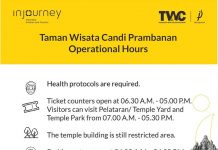The tomb of the kings of Mataram or better known as the Tomb o thef Kings in Imogiri was built in 1632 – 1640 by Sultan Agung Adi Prabu Hanyokrokusumo, Sultanate of Mataram who was the third generations of Panembahan Senopati, the first King of Mataram. The tomb complex located Ginirejo Village, Imogiri, Bantul, Yogyakarta is intended for kings and families of the Mataram Kingdom and their descendants.
Pajimatan Girirejo or the process of choosing hills to build the king’s tomb has a history. According to stories from local people, when Sultan Agung was looking for land to use as a special burial place for the sultan and his family, he threw a handful of sand from Arabia. After the sand was thrown away, it finally landed in Imogiri hill. From that reason, the Sultan ordered the tomb construction to be done in Imogiri. So, in 1632 AD began the tomb construction by an architect named Kyai Tumenggung Tjitrokoesoemo. After 13 years later Sultan Agung died and was buried in Imogiri.
The Mataram Kingdom achieved its glory during the reign of Sultan Agung because it was able to control almost all of Java. During his reign, he resisted the Dutch. In 1628 and 1629, Mataram had attacked the VOS headquarters in Batavia even though it ultimately failed. According to the story, this failure was due to the existence of retainer in Mataram who had previously leaked the planned attack to the Netherlands. The Mataram retainer, based on the story, was Tumenggung Endranata who was also buried in Imogiri Tomb.
The betrayal caused the logistical places, such as rice barns to prepare for the journey of Mataram troops to Batavia were burned by the Dutch so that the Mataram troops were easily defeated. Finally, Sultan Agung knew about the betrayal committed by one of his troops. Sultan Agung then took decisive action by arresting and punishing Tumenggung Endranata. Then the traitor’s head was beheaded, and the headless body was planted on one of the steps below the tomb’s gate.
The pilgrims could find the traitor’s tomb in the form of an elongated stone staircase. These steps are a warning to Sultan Agung followers so that there will be no more betrayal.
When entering the tomb area, it will immediately smell the scent of flowers mixed with incense. Every day, the courtiers put special offerings on the tomb. According to the caretaker of the Imogiri Tomb, the tomb of Sultan Agung always emits fragrant aromas because of his level which has arrived at Allah.
Until now, Sultan Agung’s tomb was so sacred that not just anyone could enter the tomb complex. For pilgrims who are going to make a pilgrimage, there are requirements that must be done, like pilgrims must wear Javanese or Peranakan clothing (for male pilgrims must wear Javanese clothing, such as blangkon, beskap, kain, Sabuk, timang, and Samir, while female pilgrims must wear long dresses and fabrics). They are prohibited from using footwear, wearing jewelry especially gold, and carrying a camera.
In the tomb area, visitors are prohibited from being rude, cutting trees, uprooting or damaging plants, hunting, and taking wood.
In addition, visitors can also see four barrels or padhasan which base on the story are offerings from the kingdoms of friends to Sultan Agung. The barrels have different names, namely Gentong Nyai Siyem from Siam, Gentong Kyai Mendung from Rum or Turkey, Gentong Kyai Danumaya from Aceh, and Gentong Nyai Danumurti from Pelembang. The barrels are said to have certain benefits such as health, curing or success so that many pilgrims who believe scramble to get water from these barrels.
Imogiri’s tomb is open every day. However, on certain days such as Kliwon Friday and Kliwon Tuesday, this tomb will be filled with many visitors. The pilgrims who come perform prayer rituals around the tomb, especially at midnight. The pilgrims come with their respective goals such as praying for wealth, career, success, or increasing spiritualism.
To visit the king’s tomb in Imogiri can use a personal car or bus. From Giwangan terminal take the Yogyakarta-Panggang or Yogyakarta Petoyan department. Arriving at the Imogiri terminal, visitors can just walk about 250 meters to the steps leading to the tomb.
To visit the king’s tomb in Imogiri is free of charge. Only every visitor is required to fill in the guest book and make a generous contribution to the tomb caretaker. If they also bring water from the barrel, there will be additional fees which are for a voluntary purpose.
The facilities in this place are quite adequate, such as a parking lot, public toilets and guides who will tell the history about the tomb of the King Imogiri. Visitors can also buy three small photocopy books about the history of the King Mataram’s tomb, the scheme of the king’s tomb and the history of Mataram in Kotagede. There are also several stalls at the Imogiri terminal that sell various food and drink such as wedang uwuh, pecel, jadah tempe and tahu bacem.




